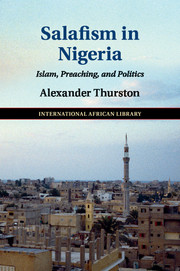Book contents
- Frontmatter
- Contents
- Acknowledgments
- List of Maps
- Introduction: Defining Salafism, Analyzing Canons
- Part I Salafism and Its Transmission
- Part II The Canon in Action
- 4 Teaching the Canon
- 5 The Canon in Religious Debates and Electronic Media
- 6 The Canon in Politics
- Part III Boko Haram and the Canon
- Conclusion
- Appendix 1 The Sermon of Necessity (Khuṭbat al-Ḥāja)
- Glossary of Persons
- Glossary of Arabic Terms
- Bibliography
- Index
- Miscellaneous Endmatter
5 - The Canon in Religious Debates and Electronic Media
from Part II - The Canon in Action
Published online by Cambridge University Press: 05 September 2016
- Frontmatter
- Contents
- Acknowledgments
- List of Maps
- Introduction: Defining Salafism, Analyzing Canons
- Part I Salafism and Its Transmission
- Part II The Canon in Action
- 4 Teaching the Canon
- 5 The Canon in Religious Debates and Electronic Media
- 6 The Canon in Politics
- Part III Boko Haram and the Canon
- Conclusion
- Appendix 1 The Sermon of Necessity (Khuṭbat al-Ḥāja)
- Glossary of Persons
- Glossary of Arabic Terms
- Bibliography
- Index
- Miscellaneous Endmatter
Summary
In November 2006, Shaykh Jaʿfar Ādam addressed supporters in Kano. In his lecture, “The Struggle between Falsehood and Truth,” he treated a controversy surrounding a mosque in Kano's Sabuwar Gandu neighborhood. He explained that the Salafi community had built the mosque. But, he claimed, Kano's most powerful forces had blocked Salafis' choice of imam. These forces numbered three: the Tijaniyya Sufi order, for which Kano has been a stronghold since the early twentieth century; Emir Ado Bayero (1930–2014, reigned 1963–2014), the city's hereditary Muslim ruler and a member of the Tijaniyya; and politicians such as Governor Ibrahim Shekarau (b. 1955, served 2003–11), whom Ādam accused of catering to the Tijaniyya and the emir.
Against this perceived coalition, Ādam deployed one of the Salafi community's main assets: media engagement. In a recorded lecture, he marshaled proof-texts to make his case for the Salafi community's ownership of the mosque. He cited Qurʾanic verses and ḥadīth reports, but he also extended Salafism's ideal of textualism to include secular documents, such as news clips, legal documents, and letters. In Kano's diverse and charged media landscape, Ādam's lecture circulated in recorded form. The lecture contributed to tensions that culminated in violence between Salafis and the Tijaniyya, as well as a legal suit Salafis launched against the emir and the governor. The physical conflict ended with a literal standoff: Salafis retained control in Sabuwar Gandu, but the Tijaniyya built an imposing new mosque within sight of the Salafi enclave. In the media, however, the conflict continued: Salafis systematically promoted their narrative, seeking to define understandings of the controversy within Kano even after the question of mosque control was resolved. As Salafis mediatize conflict such as Sabuwar Gandu, meanwhile, Sufis and other critics of Salafism have begun turning to electronic media to denounce Salafism, question its canon, and assert the value of other canons.
In the twentieth and twenty-first centuries, the rise of electronic media has confronted religious communities with dramatic changes. Electronic media have thrust some believers into new spaces where the meaning of texts, the boundary between public and private, and the nature of religious authority are transformed. Scholars of religion have highlighted how religious media can affect “local, everyday, embodied forms of religious practice and affinity,” or modes of ethical “self-fashioning.”
- Type
- Chapter
- Information
- Salafism in NigeriaIslam, Preaching, and Politics, pp. 140 - 167Publisher: Cambridge University PressPrint publication year: 2016

